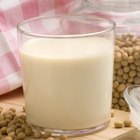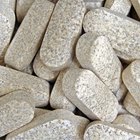
You’ll get the same tangy flavor from whole and low-fat buttermilk, so when you have a choice about which one to buy, go with the low-fat brand. They have the same amount of protein and calcium, but whole buttermilk has significantly more total fat and artery-clogging saturated fat. The difference in fat also means that whole buttermilk has more calories.
Basics
When milk is churned by hand to produce butter, the liquid that remains is buttermilk. The buttermilk found in your local store, often called cultured buttermilk, is different because it’s made by adding bacterial cultures to whole, low-fat or skim milk and letting it ferment. One cup of low-fat buttermilk only has 98 calories, compared to 152 calories in whole buttermilk. They both have 12 grams of carbohydrates and 8 grams of complete protein.
Fat Profile
Whole buttermilk has four times more total and saturated fat than low-fat buttermilk. One cup of whole buttermilk has 8 grams of total fat, which is low enough to work into your daily diet, but its saturated fat presents a problem. With 4.7 grams of saturated fat, just 1 cup of whole buttermilk supplies almost one-third of an entire day's recommended intake limit. By comparison, low-fat buttermilk only has 2 grams of total fat and 1.3 grams of saturated fat. One cup of low-fat buttermilk contains 10 milligrams of cholesterol; whole buttermilk has three times that amount.
Calcium
Your bones reach their peak strength between the ages of 20 and 30. After that, they lose about 0.5 to 1 percent of their density every year until menopause, when the loss of minerals increases. Besides this natural loss, old bone is continuously replaced with new bone throughout your life and you need calcium for its roles outside your bones, where it stimulates heart muscles and nerves. All of this activity demands a regular supply of calcium -- 1,000 milligrams daily -- so your body always has enough to maintain strong bones. Whole and low-fat buttermilk are both rich sources of calcium, supplying 28 percent of your recommended daily allowance in a 1-cup serving.
Vitamin A
Vitamin A is essential for vision, but it also contributes to healthy skin and a strong immune system. Some vitamin A is lost along with the milk fat when it's removed to produce low-fat buttermilk. Even though low-fat milk must be fortified with vitamin A, it may still contain less than the natural amount in whole milk. One cup of whole buttermilk has 404 international units of vitamin A, compared with only 115 international units in the same portion of low-fat buttermilk. Since women need 2,333 international units daily, you’ll get 17 percent of your daily allowance of vitamin A from whole buttermilk and only 5 percent from low-fat buttermilk.
Related Articles

Muenster Cheese Health Benefits

Nutritional Information on Turkey vs. ...

What Are the Benefits of Whole Grain ...

The Average Weight of a Boiled Egg

Facts About Yoplait Yogurt

Whole Milk Vs. Lactaid Milk

Why Is Milk So Fattening?

Is Soy Milk Casein-Free?

The Role of Collagen & Melanin in Skin
Can Adults Drink Whole Milk?
Nutrition Information for Onken Yogurt

What Vitamins Help the Liver?

Fat in Whole Chicken vs. Chicken Breast

Is Homemade Butter Better Than ...

Nutrition Information For a 16-Ounce ...

Heavy Cream vs. Milk in Baking

The Best Anti-Cellulite Supplements

Can You Substitute Yogurt for ...

How to Store Ghee

Substitute for Milk in Instant Potatoes
References
Writer Bio
Sandi Busch received a Bachelor of Arts in psychology, then pursued training in nursing and nutrition. She taught families to plan and prepare special diets, worked as a therapeutic support specialist, and now writes about her favorite topics – nutrition, food, families and parenting – for hospitals and trade magazines.
Photo Credits
Burke/Triolo Productions/Brand X Pictures/Getty Images